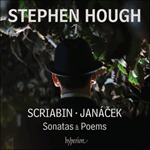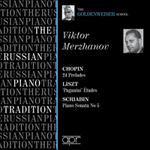
Welcome to Hyperion Records, a British classical label devoted to presenting high-quality recordings of music of all styles and from all periods from the twelfth century to the twenty-first.
Hyperion offers both CDs, and downloads in a number of formats. The site is also available in several languages.
Please use the dropdown buttons to set your preferred options, or use the checkbox to accept the defaults.

I call you to life, mysterious forces!
Drowned in the obscure depths
of the creative spirit, timid
Embryos of life, to you I bring audacity!
—a vivid description of the release of material from the unconscious mind necessary for the creation of such a complex and innovative work in such a short space of time. Like the Fourth, the Fifth Sonata belongs to the middle period of Scriabin’s music where harmony relates directly and clearly to the tonal system, but many features point already to the final phase. The general plan is of a slow introduction followed by a sonata movement, but slow and fast sections alternate throughout. The piece begins and ends with a fantastical passage of sheer sonority, quite anti-tonal in effect (though, characteristically, based firmly on a mode): starting with subterranean rumblings it flashes rapidly through the range of the keyboard and vanishes, as it were, from sight. The elementally simple motives of the languid prologue artfully foreshadow the themes which are to emerge later. The dance of the ensuing Presto takes up where the Fourth Sonata left off, and there are clear programmatic references to the epigraph: imperious fanfares are answered by distant, fearful shudderings. The third subject, in a slower tempo, is the closest to the atmosphere of the ‘Poem of Ecstasy’: marked ‘caressingly’, and taking chromaticism its furthest yet, it is steeped in sensuality.
At the centre of the piece, marked ‘with delight’, appears the so-called ‘Mystic’ or ‘Promethean’ harmony which was to become the basis of Scriabin’s late style. Mysterious and sophisticated in sonority, it has a simple origin as a chromatically altered dominant chord arranged in fourths instead of thirds.
At the recapitulation Scriabin introduces a new technique: the opening bars are brought back in miniature, speeded up and lightened so that we ‘fly’ through them. This does not prevent a final, ecstatic reprise of the prologue theme with Scriabin’s usual vibrating repeated chords—but, unlike earlier works, the theme is not in octaves but more luminously in single notes in the treble, another characteristic of the late style. The final bars, identical to the beginning, baffled Taneiev, who remarked that the Sonata did not finish but just stopped; this ending could also be thought of as a new beginning, suggesting repeated cycles of creation—Nietzsche’s ‘Eternal Recurrence’.
from notes by Simon Nicholls © 1996
Je vous appelle à la vie, ô forces mystérieuses!
Noyées dans les obscures profondeurs
De l’esprit créateur, craintives
Ebauches de la vie, à vous j’apporte l’audace.
Il s’agit d’une description frappante de la production de l’inconscient nécessaire à la création en un si court laps de temps d’une œuvre aussi complexe et novatrice. De même que la quatrième sonate, la cinquième appartient à la période intermédiaire de la musique de Scriabine, où l’harmonie est en relation claire et directe avec le système tonal, mais dont de nombreuses caractéristiques indiquent la phase finale. Le plan général se compose d’une introduction lente suivie d’un mouvement de sonate, tout au long duquel se suivent néanmoins des passages lents et rapides. Ce morceau débute et se termine sur des passages fantastiques aux sonorités très pures, avec un effet assez atonal (bien que caractéristiquement fermement ancré dans un mode): commençant par des roulements souterrains, traversant de façon fulgurante la longueur du clavier, puis s’évanouissant, comme disparaissant à la vue. Les motifs d’une simplicité élémentaire du languissant prologue sont de judicieux signes précurseurs des thèmes émergeant par la suite. La danse du Presto qui s’en suit, débute là où se termine la quatrième sonate, et on y décèle des références très claires à l’épigraphe: des frémissements craintifs font écho à des fanfares impérieuses. Le troisième thème, au tempo plus lent, annoté «avec tendresse» est celui qui se rapproche le plus de l’atmosphère du «Poème de l’Extase»; il pousse le chromatisme à son extrême et est rempli de sensualité. Au milieu du morceau apparaît, annoté «avec délice», l’harmonie qualifiée de «mystique» ou de «prométhéenne», qui allait devenir la base du futur style de Scriabine. Avec des sonorités mystérieuses et sophistiquées, cette harmonie prend sa source par un accord dominant chromatiquement altéré et en quartes plutôt qu’en tierces.
Scriabine profite de la récapitulation pour introduire une nouvelle technique: les premières mesures sont ramenées en miniature, accélérées et éclaircies de sorte que l’on a le sentiment de les traverser en volant. Ceci n’empêche pas une reprise finale extatique du thème du prologue avec la répétition des habituels accords vibrants de Scriabine. Cependant, contrairement à ses œuvres antérieures, le thème n’est pas en octaves, mais de façon plus lumineuse, en notes simples dans les aigus, une autre caractéristique de son style ultérieur. Les dernières mesures, identiques aux premières, déconcertèrent Tanaiev qui remarqua que la sonate ne se terminait pas mais ne faisait que s’arrêter. Cette fin peut également s’interpréter comme un nouveau commencement, le cycle sans fin de la création—la «Récurrence éternelle» de Nietzsche.
extrait des notes rédigées par Simon Nicholls © 1996
Français: Alexandre Blanchard
Ich rufe euch ins Leben, geheimnisvolle Kräfte!
Versunken in der unerforschten Tiefe
des Schöpfergeistes, ängstliche
Keimlinge des Lebens, euch bringe ich Mut!
Eine lebendige Beschreibung der Freisetzung von Material aus dem Unterbewußtsein, das für die Schöpfung eines solch komplizierten und innovativen Werks in einer solch kurzen Zeit unentbehrlich ist. Wie die Vierte gehörte auch die Fünfte Sonate in die mittlere Periode in Skrjabins Musik, wo die Harmonie direkt und deutlich auf das tonale System bezogen ist, aber viele Merkmale auf die letzte Phase deuten. Der Generalplan besteht aus einer langsamen Einführung gefolgt von einem Sonatensatz, jedoch wechseln sich langsame und schnelle Abschnitte ständig ab. Das Stück beginnt und endet mit einer phantastischen Passage reiner Klangfülle, ihre Wirkung ganz antitonal (beruht bezeichnenderweise doch fest auf einem Tongeschlecht): nach dem unterirdischen Grollen am Anfang durchläuft sie blitzschnell den gesamten Umfang der Tastatur und verschwindet sozusagen aus den Augen. Die grundsätzlich einfachen Motive des schleppenden Prologs signalisieren geschickt die Themen, die sich später entwickeln werden. Der Tanz des anschließenden Prestos greift das wieder auf, was die Vierte Sonate verlassen hat, und die programmatische Bezugnahme auf das Epigraph ist sehr deutlich: zu dringenden Fanfaren ertönt das Echo fernen, angstvollen Bebens. Das dritte, langsamere Thema kommt der Stimmung des „Gedichts der Extase“ am nächsten: es ist als „streichelnd“ bezeichnet und, während es die Chromatik zu ihren äußersten Grenzen führt, ist es durchdrungen von Sinnlichkeit.
In der Mitte des Stücks erscheint unter der Bezeichnung „freudig“ die sogenannte „mystische“ oder „promethische“ Harmonie, die zur Grundlage für Skrjabins späten Stil werden sollte. Trotz seiner Mystik und edlen Klangfülle ist sein Ursprung als ein chromatisch veränderter Dominantenakkord, der in Quarten anstatt Terzen aufgebaut ist, jedoch einfach.
Bei der Reprise stellt Skrjabin eine neue Technik vor: die Einleitungstakte werden als Miniatur zurückgebracht, dabei beschleunigt und leichter, so daß wir durch sie „fliegen“. Damit ist eine letzte ekstatische Reprise des Prologthemas mit Skrjabins gewohnten vibrierenden wiederholten Akkorden aber nicht ausgeschlossen—doch im Gegensatz zu früheren Werken ist das Thema nicht in Oktaven, sondern durchscheinender in Einzelnoten im Diskant angelegt, ein weiteres Merkmal seines späten Stils. Die letzten Takte, die mit denen am Anfang identisch sind, verblüfften Tanejew, der die Bemerkung machte, daß die Sonate keinen Abschluß hatte, sondern einfach aufhörte; dieses Ende könnte auch als ein neuer Anfang mit immer wiederkehrenden Zyklen der Schöpfung gedeutet werden—Nietzsches „Ewige Wiederkehr“.
aus dem Begleittext von Simon Nicholls © 1996
Deutsch: Meckie Hellary
 Scriabin & Janáček: Sonatas & Poems Scriabin & Janáček: Sonatas & PoemsTwo eccentric Slavs are brought together under the fingers of an English gentleman—genius abounds.» More |
 Viktor Merzhanov - Chopin, Liszt & Scriabin Viktor Merzhanov - Chopin, Liszt & Scriabin BBC Music Magazine BBC Music Magazine‘APR has provided a rare chance for pianophiles to easily access Merzhanov in his prime, so don’t hesitate’ (Classics Today)» More |

